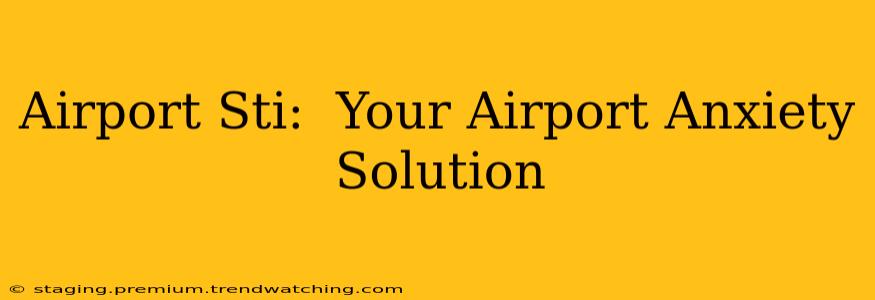Flying can be stressful. Between navigating security lines, worrying about delays, and the sheer chaos of a bustling airport, it's no wonder many people experience airport anxiety. This isn't just about being a little nervous; for some, the fear is crippling, impacting their ability to travel altogether. This comprehensive guide will explore the root causes of airport anxiety, offer practical coping mechanisms, and provide you with strategies to navigate the airport with confidence and ease. We'll even address some common misconceptions and anxieties surrounding airport security and travel in general.
What is Airport Anxiety?
Airport anxiety is a specific type of anxiety disorder characterized by intense fear and apprehension related to airports and air travel. Symptoms can range from mild discomfort and nervousness to full-blown panic attacks. These feelings are often triggered by specific aspects of the airport experience, such as crowded spaces, security checks, potential delays, or the fear of flying itself. Unlike a general fear of flying (aviophobia), airport anxiety focuses specifically on the pre-flight experience within the airport environment.
What Causes Airport Anxiety?
Several factors contribute to airport anxiety. Understanding these underlying causes can be the first step towards managing it effectively.
Fear of the Unknown: The unpredictable nature of air travel, potential delays, and unexpected events can fuel anxiety. Lack of control over the situation exacerbates these feelings.
Crowds and Confined Spaces: Airports are inherently crowded places. For individuals with social anxiety or claustrophobia, these environments can be particularly triggering.
Security Procedures: The security screening process can be intimidating and anxiety-provoking, particularly for those unfamiliar with the procedures or who fear invasive searches.
Past Negative Experiences: Previous negative experiences at airports, such as missed flights, lost luggage, or stressful encounters, can contribute to a heightened sense of anxiety during future travels.
How to Manage Airport Anxiety: Practical Strategies
Managing airport anxiety requires a multi-faceted approach. Here are several effective strategies you can implement:
Planning and Preparation: Meticulous planning is key. Allow ample time for check-in, security, and boarding. Research your airport thoroughly, identifying the location of gates, restrooms, and amenities. Pre-booking your parking or utilizing airport transportation services can reduce stress.
Deep Breathing and Relaxation Techniques: Practicing deep breathing exercises, meditation, or mindfulness techniques can significantly reduce anxiety levels. Apps and online resources offer guided meditations specifically designed to manage anxiety.
Cognitive Behavioral Therapy (CBT): CBT is a highly effective therapy for anxiety disorders. A therapist can help you identify and challenge negative thoughts and develop coping mechanisms to manage anxiety-provoking situations.
Medication: In some cases, medication may be necessary to manage severe anxiety. Consult a doctor or psychiatrist to discuss appropriate options.
Addressing Common Airport Anxiety Triggers:
Here, we address some of the most frequently asked questions related to airport anxiety:
How can I cope with long security lines?
Bring a book, download podcasts, or utilize airport Wi-Fi to catch up on emails. Remember, everyone is in the same boat, and focusing on a calming activity can help distract you from the wait.
What if I miss my flight?
While missing a flight is undeniably stressful, remember that airlines and airports have procedures in place to assist passengers. Focus on what you can control, such as arriving early and staying organized. Travel insurance can provide additional peace of mind.
How do I deal with claustrophobia in the airport?
Identify less crowded areas within the airport. Take frequent breaks in open spaces, and consider using earplugs or noise-canceling headphones to reduce sensory overload.
What if I have a panic attack?
If you experience a panic attack, find a quiet place to sit down. Practice deep breathing exercises, and if necessary, seek assistance from airport staff or medical personnel.
Beyond the Practical: A Holistic Approach
Managing airport anxiety is not solely about practical strategies; it also involves fostering a sense of self-compassion and understanding. Acknowledge that anxiety is a valid emotion and that you are not alone in experiencing it. Remember that airports, while sometimes stressful, are designed to facilitate travel – a process that ultimately leads to new experiences and adventures.
By combining practical strategies with a mindful and compassionate approach, you can conquer your airport anxiety and rediscover the joy of travel. Remember, seeking professional help is a sign of strength, not weakness. If your anxiety significantly impacts your life, don't hesitate to reach out to a mental health professional.

